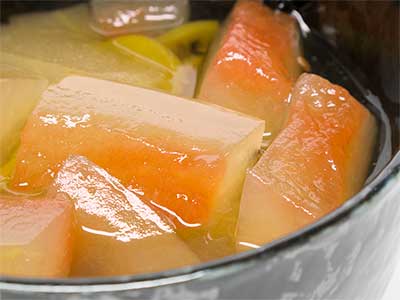October 13, 2014
Amuse-Bouche

mariné zeste de pastèque
(pickled watermelon rind)
Pickle as a noun meant the kosher dills from a local German delicatessen. Pickled as an adjective meant herring in sour cream. Both were part of my childhood, introduced to my palate by my Bavarian-born mother. At the same time, watermelon indicated a very hot day when we’d eat outside rather than in our hot kitchen. It also meant a dessert that didn’t interest me much. Each mouthful contained too much water and seeds and not enough flavor. The melon would always be served as a thick slice, and as I ate it closer to the rind, the minimal flavor was further reduced. Then, much later, pickled watermelon rind came into my field of view.
I have no idea who decided to take waste from the watermelon and transform it with a vinegar-sugar-chili pickling solution, but if we are ever introduced, I will thank that person profusely. (The earliest recipe I’ve found is in the tenth edition of Directions for Cookery, in its Various Branches by Miss Leslie, published in 1840. I doubt if I’ll ever get a chance to shake her hand, assuming she was the inventor.) I think it’s been less than fifteen years since I first tasted this pickle, and I immediately liked it. Amazingly, I think I’ve only eaten pickled watermelon rind once or twice since then.
Back in August, Jeff Parker posted a recipe for jalapeño pickled watermelon rind on his blog Jeff Parker Cooks. I copied the recipe and set the copy aside in my “Recipes to Try” folder, but it didn’t sit there long. Within a few weeks, I purchased my first whole watermelon of the millennium so I could prepare three pounds of watermelon salad for a party I was catering later in the week. Although I saved the rind from the part of the melon I used, it went bad in my refrigerator before I got to it. Luckily, there was still a chunk of watermelon tightly wrapped in plastic further back in the frig. The flesh was used for the soupe de melon posting later this year. The rind was used for this posting.
As I started to prepare the recipe, I realized that I was missing two ingredients: The ginger I knew I was out of, but I thought I had whole allspice berries in my cupboard. Wrong. So I quickly decided to substitute dried lavender, hoping for a slight floral scent in the finished product.
If you compare the original recipe to the one below, you’ll see that I adopted a more adaptive approach to the ingredient quantities. (One method isn’t better than the other, it’s just that my style of recipe writing is different.)
watermelon rind with some pink flesh still attached
1 large
jalapeño pepper, stem removed, 3-mm (1⁄8-in) thick crosswise slices
325 ml (1-1⁄3 c)
distilled, white vinegar
160 ml (11⁄16 c)
filtered water
275 g (1-3⁄8 c)
granulated sugar
17 g (5-1⁄3 t)
fine salt
6 g
whole, black peppercorns
1.5 g
dried lavender
1. Trim the watermelon rind into bite-sized pieces. Neaten up any weird ends. The pieces should “look” like they are the same size. Once sized, peel the skin from each piece with a vegetable peeler.
2. Add the trimmed rind to a container with vertical sides, like a large jar. Add water to the container until the rind is covered. It will probably start to float. Pour the water off and collect it in a measuring cup. The pickling ingredient quantities above are based on a water measurement of 760 milliliters (scant 3-1⁄4 cups). Proportion the above quantities to fit your liquid requirements. For example, if you measured 950 milliliters (4 cups) of water, the amount of distilled vinegar required would be original vinegar quantity times new total volume divided by original total volume, or 325 x 950 ÷ 760. The size and quantity of the jalapeño peppers can be adjusted by guess.
3. Place all the ingredients except the rind in a saucepan over high heat. When the liquid comes to a boil and the sugar is dissolved, add the rind. When the liquid returns to a boil, reduce the heat. Simmer the rind for 2 minutes.
4. Remove the saucepan from the heat, cover, and set aside to cool to room temperature.
5. When the liquid has cooled to room temperature, place the whole pot in your refrigerator to chill overnight. If you wish, everything can be transferred to a different container for chilling.
6. Package the pickle in sealed containers and refrigerate until needed.
7. Note: For long-term storage, drain the rind and vacuum pack the pieces in a plastic bag.
© 2014 Peter Hertzmann. All rights reserved.
